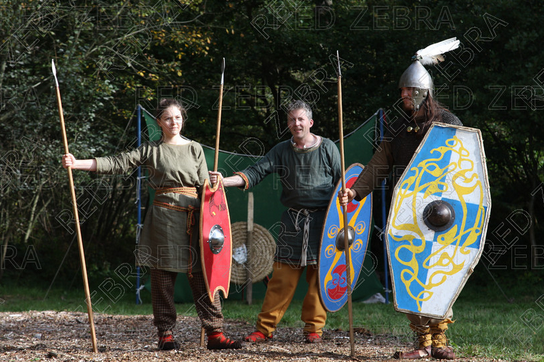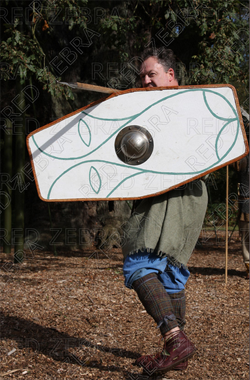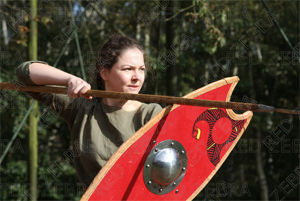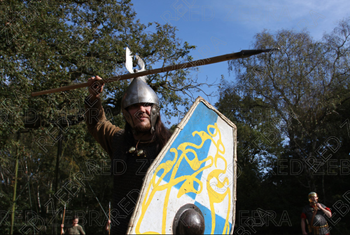HOME ● WHAT WE DO ● EVENTS ● CONTACT ● MEMBERSHIP ●RESOURCES● GALLERY
British Warriors

The Vicus represents Britons of the first century AD and by limiting ourselves to this period just after the conquest then we can actually bring our Britons and Romans together in a struggle that lasts at least half a century.
Whether they are resisting the initial invasion, fighting a guerilla war in Wales or fighting in open rebellion with Boudicca or Venutius, then there is always a role for the belligerent native.
We do not represent any particular tribe as our members are spread across the country.
 As there is no primary evidence for the military structure of Iron Age Britain, then it is perhaps permissible to look at other cultures and later periods. The "warband" structure of Ireland, later Wales and Europe is perhaps the most likely.
As there is no primary evidence for the military structure of Iron Age Britain, then it is perhaps permissible to look at other cultures and later periods. The "warband" structure of Ireland, later Wales and Europe is perhaps the most likely.In these models, the tribal leadership would maintain a permanent number of fighting men, who would "wine and dine" at their leaders expense and receive gifts in return for defending their leader and their tribe.
Warfare is mostly limited to small scale skirmishes between tribes, probably over moveable goods, although larger tribal struggles (such as those initiated by the catavallauni) are not unknown. Only those warriors within the warbands would fight, in the usual run of things, but other classes could be called upon to defend their homes if required or during other times of tribal crisis
The primary weapons in this period are the same as they were for a thousand years both before and afterwards; namely the single hand spear and shield. If a warrior possesses a sword then it would also be a single-handed weapon used in conjunction with his, or her, shield.
Multiple spears would be carried into battle for use as javelins. Massed archery is a tactic of the future, although slings and bows were used.
There are more iron age helmet and mail finds in both Britain and Europe than in some later periods, demonstrating perhaps that the image of naked savages relying solely upon their own courage for protection is not the right one.
Although it is unlikely to be cheap, a helmet would be one of first pieces of equipment that any professional warrior would obtain as the majority of blows would be directed to the head. Not only are most vital functions located there but it is one of the few parts of the body not to be covered by the large shields.

The group, understandably, has quite a number of helmets among it's members. Some of these are based on continental examples such as this odd shaped example now in the museum in mainz. Click here to see the original.
Shields would be universally used by warriors. The use of massed double hand spears (or pikes or bills) is still over a thousand years in the future.
Remember that many warriors would not be armoured and any armour, if it is worn, would only be of mail and cover only the torso and so with the number of thrown weapons being utilised, especially by the Romans, any unshielded force could be annihilated before it ever reached it's enemy. Read an article on spears and shields here
Although some shields are quite large, we have found that shields the size of the battersea and witham shields (click here for more information on those) are very usable and provide far more protection than might be thought.

 This period is one of the few where women can be warriors in their own right. Certainly the Britons have women rulers and it is highly likely that there are female warriors in the ranks. Exactly how many women were "professional" warriors in any given tribe is unknown.
This period is one of the few where women can be warriors in their own right. Certainly the Britons have women rulers and it is highly likely that there are female warriors in the ranks. Exactly how many women were "professional" warriors in any given tribe is unknown.
However, the Vicus also has no problem with women being roman legionarys, although that is realistically very unlikely. At the end of the day, we are 21st century people pretending to be Romans and Britons not some 19th century misogynist "Gentleman's Club" with outdated ideas of a woman's place.
Although some shields are quite large, we have found that shields the size of the battersea and witham shields (click here for more information on those) are very usable and provide far more protection than might be thought.

 This period is one of the few where women can be warriors in their own right. Certainly the Britons have women rulers and it is highly likely that there are female warriors in the ranks. Exactly how many women were "professional" warriors in any given tribe is unknown.
This period is one of the few where women can be warriors in their own right. Certainly the Britons have women rulers and it is highly likely that there are female warriors in the ranks. Exactly how many women were "professional" warriors in any given tribe is unknown. However, the Vicus also has no problem with women being roman legionarys, although that is realistically very unlikely. At the end of the day, we are 21st century people pretending to be Romans and Britons not some 19th century misogynist "Gentleman's Club" with outdated ideas of a woman's place.
Other relevant articles in our resources section on British Warrior equipment include:

The Vicus © 2004
All information on this website has been written by members of the group unless other source has been stated. All photographs have been taken by members of the group and belong to The Vicus. Any images not taken by the group have been credited.
HOME ● WHAT WE DO● EVENTS ● MEMBERSHIP ● BOOKING ● GALLERY ● CONTACT ●GLADIATORS ● BRITISH WARRIORS ● ROMAN UNITS● RELIABLE RESOURCES